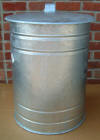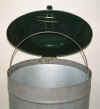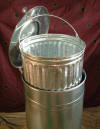|
Dog Poop & Pet Waste
Dog waste poses threat to water
By Traci Watson, USA TODAY
06/06/2002
For as long as the dog has been man's best friend, dog
waste has posed a menace to man's nose and foot. Now science has revealed a more
unsavory truth: It's an environmental pollutant.
In the mid-1990s, scientists perfected methods for
tracking the origin of nasty bacteria in streams and seawater. From Clearwater,
Fla., to Arlington, Va., to Boise the trail has led straight to the hunched-up
dog — and to owners who don't pick up after their pets.
At some beaches, dogs help raise bacteria levels so high
that visitors must stay out of the water. Goaded by such studies, some cities
have directed as much as $10,000 in the last few years to encourage dog owners
to clean up after their pets. A few municipalities have started issuing
citations to those who ignore pet clean-up ordinances.
Many dog lovers are in denial about their pooches'
leavings. But researchers have named the idea that areas used by dogs pump more
bacteria into waterways — the "Fido hypothesis."
Dogs are only one of many fixtures of suburban America
that add to water pollution. Lawn fertilizers, rinse water from driveways and
motor oil commonly end up in streams and lakes.
But unlike those sources, dogs generate disease-causing
bacteria that can make people sick. Studies done in the last few years put dogs
third or fourth on the list of contributors to bacteria in contaminated waters.
"Dogs are one of our usual suspects," says Valerie Harwood, a microbiologist at
the University of South Florida. "At certain sites, we find their effect to be
significant."
It doesn't take a Ph.D. to figure out that dog do is
nasty. But it took science to determine how nasty it is.
From mutt to blue-blooded champion, all dogs harbor
so-called coliform bacteria, which live in the gut. The group includes E. coli,
a bacterium that can cause disease, and fecal coliform bacteria, which spread
through feces. Dogs also carry salmonella and giardia. Environmental officials
use measurements of some of these bacteria as barometers of how much fecal
matter has contaminated a body of water.
This wouldn't matter if pet dogs were as rare as pet
chinchillas. But four in 10 U.S. households include at least one dog, according
to the American Pet Products Manufacturers Association. The association's
statistics also show that Americans owned 54.6 million dogs in 1996 and 68
million dogs in 2000. Of that total, 45% were "large" dogs — 40 pounds or more.
Those numbers add up to a lot of kibble. That wouldn't
matter if all dog owners also owned a pooper-scooper. But several studies have
found that roughly 40% of Americans don't pick up their dogs' feces (women are
more likely to do so than men).
New analysis provides answers
The environmental impact of dog waste went unrecognized
for decades. Then scientists developed lab techniques to determine the origin of
fecal bacteria contaminating water. One method is a variant of DNA
fingerprinting. Another method looks at the antibiotic resistance of microbes
from different species.
Scientists caution that the methods are still new. They
are able to distinguish between major and minor sources of pollution, but they
can't say with precision whether dogs contribute 20% or 30% of the pollution in
a stream. "There's inherently some error," says Don Stoeckel, a microbiologist
for the Ohio district of the U.S. Geological Survey who's studying
bacteria-tracking methods. "I think the best (they) can do is give you some
evidence of the magnitude of each source."
Nonetheless, Stoeckel says, the analytical tools do
provide useful information. Researchers have studied dozens of waterways. Wild
birds and humans usually head the roster of who's fouling the water. But in some
areas, dogs make significant deposits.
At Morro Bay, Calif., for example, dogs contribute
roughly 10% of the E. coli, says Christopher Kitts, a microbiologist at
California Polytechnic State University-San Luis Obispo. "And that can be the
difference between a beach closing and a beach not closing," he says.
Places where dogs dirty the water:
- Stevenson Creek in Clearwater, Fla. Residents were worried that a
sewage treatment plant contaminated the creek. But when Harwood tested the
water, she found that dogs, along with leaky septic tanks and wild animals,
were to blame for high bacteria counts. Dog feces probably washed out of yards
by the creek, Harwood says.
- Four Mile Run in Arlington and Fairfax counties, Va. Studies show
that dogs add to the contamination in this suburban Washington, D.C. stream.
Officials calculate that the 12,000 dogs living in Four Mile Run's watershed
leave behind more than 5,000 pounds of "solid waste" every day.
- Boise River in Boise. The river suffers from high bacteria levels
that make it unsuitable for swimming. Testing of streams and drainpipes
flowing into the river showed that in urban areas, dogs were a leading
culprit. In some spots, dogs and cats account for even more of the bacteria
than human feces — from dysfunctional septic tanks and leaky sewage pipes —
do.
Fines don't sway some
Even where dogs aren't the prime offenders, they're one
of the few polluters authorities have control over. At many California beaches,
for example, seagulls and other birds are most responsible for high bacteria
levels. But federal laws protect birds.
That leaves dogs. Officials know that they have a lot of
educating to do before people realize their pooch can be a canine sewage pipe.
Some people find it humiliating to carry a plastic bag.
A survey by the Center for Watershed Protection in 1999
found that of the 41% of respondents who rarely or never clean up after their
dogs, 44% would refuse to do so in the face of fines and neighbors' complaints.
Reasons included, "because it eventually goes away," "small dog, small waste,"
and "just because."
So more cities may follow the lead of Laguna Beach,
Calif., a wealthy beach enclave. The city provides pooper-scoopers at the local
dog park. But many people "don't take care of their little friends," says Victor
Hillstead, the city's parks and buildings manager.
So the city hired Entre-Manure, poop-scooping service
based in nearby Dana Point whose motto is "#1 in the #2 Business." Since the
city's contract started in January, the service has collected 187 pounds of dog
waste from the city. "I'm real proud of that fact," says Craig Stern, founder
and chief picker-upper. "That's pollution that'll never reach the ocean."
 Click
the pictures below for sizes and specifications Click
the pictures below for sizes and specifications
Chief and Dover in-ground
trash cans are no longer available.
 |
 |
 |
20 gal
Dover Cans
DISCONTINUED |
20 & 25 gal
Camber Cans |
27 gal
Chief Cans
DISCONTINUED, but...
SOME PARTS AVAILABLE |
Go To :
Installation
of Underground Garbage Cans
| 







